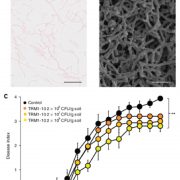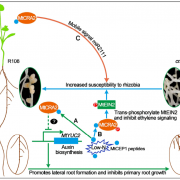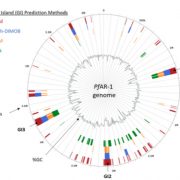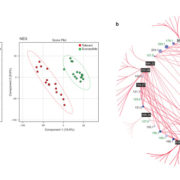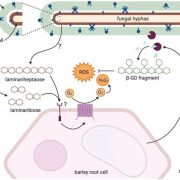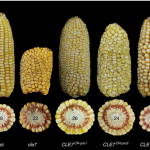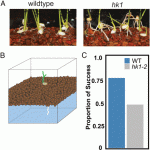Phytoplasma effector physically interacts with host proteasome to promote bacterial growth
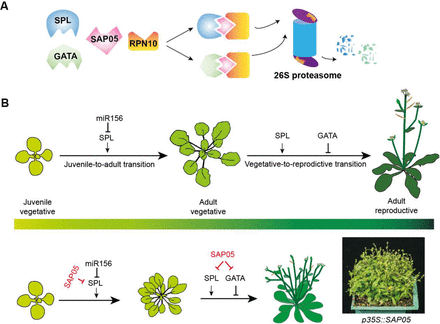 As a way to circumnavigate the plant innate immune system, phytopathogens evolved effector molecules that protect the pathogen from the plant’s defenses. SAP05, an effector from the insect-vectored phytoplasma Candidatus (a bacterial obligate parasite), is responsible for the plant phenotype observed in witches broom disease, characterized by increased vegetative growth and disrupted reproductive growth. In this exciting new research, Huang and colleagues investigate the SAP05 method of action, and demonstrate that SAP05 directly interacts with Arabidopsis ubiquitin receptor, AtRPN10, as well as members of the host transcription factor (TF) families, GATA and SPL, responsible for mediating growth and development. This paper demonstrates a novel destabilization strategy wherein SAP05 bridges GATA or SPL and AtRPN10 in a ubiquitin-independent manner, allowing RPN10 to destabilize the TFs. The simultaneous destabilization of GATA and SPL TF families causes the decoupling of developmental transitions in infected plants, allowing rampant bacterial proliferation in plant tissues. Despite the highly conserved sequence of RPN10 within eukaryotes, SAP05 targets two sequential lowly-conserved residues in AtPRN10. Mutation of AtRPN10 to resemble that of the insect vector prevents SAP05 binding, and effectively confers resistance to the SAP05 effector. In elucidating this novel mechanism, this paper provides viable avenues for therapeutic degradation of target proteins, as well as options for improving plant resistance to phytoplasma pathogens. (Summary by Marlo Hall @marloXplants). bioRxiv 10.1101/2021.02.15.430920
As a way to circumnavigate the plant innate immune system, phytopathogens evolved effector molecules that protect the pathogen from the plant’s defenses. SAP05, an effector from the insect-vectored phytoplasma Candidatus (a bacterial obligate parasite), is responsible for the plant phenotype observed in witches broom disease, characterized by increased vegetative growth and disrupted reproductive growth. In this exciting new research, Huang and colleagues investigate the SAP05 method of action, and demonstrate that SAP05 directly interacts with Arabidopsis ubiquitin receptor, AtRPN10, as well as members of the host transcription factor (TF) families, GATA and SPL, responsible for mediating growth and development. This paper demonstrates a novel destabilization strategy wherein SAP05 bridges GATA or SPL and AtRPN10 in a ubiquitin-independent manner, allowing RPN10 to destabilize the TFs. The simultaneous destabilization of GATA and SPL TF families causes the decoupling of developmental transitions in infected plants, allowing rampant bacterial proliferation in plant tissues. Despite the highly conserved sequence of RPN10 within eukaryotes, SAP05 targets two sequential lowly-conserved residues in AtPRN10. Mutation of AtRPN10 to resemble that of the insect vector prevents SAP05 binding, and effectively confers resistance to the SAP05 effector. In elucidating this novel mechanism, this paper provides viable avenues for therapeutic degradation of target proteins, as well as options for improving plant resistance to phytoplasma pathogens. (Summary by Marlo Hall @marloXplants). bioRxiv 10.1101/2021.02.15.430920


